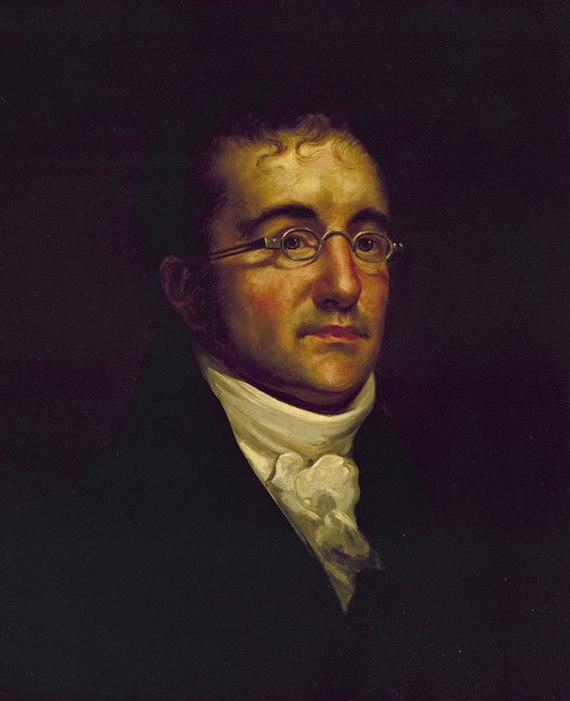Benjamin Latrobe
American architect Benjamin Latrobe designed plans for the US Capitol and other buildings. He came to New Orleans to develop waterworks and wrote about the city in his journal.

Courtesy of Architect of the Capitol
Benjamin Henry Latrobe. Costaggini, Filippo (Artist)
Considered the founder of professional architecture in America, Benjamin Latrobe is best known for his design of the US Capitol in Washington, DC, and the Basilica of the Assumption of the Blessed Virgin Mary in Baltimore, Maryland. His talent allowed him to excel in his profession on the East Coast, as well as in Louisiana. In New Orleans, Latrobe designed a central steeple for St. Louis Cathedral, the US Custom House, and a municipal waterworks plan, among other projects. His illustrated journal, dating from 1818 to 1820, furnishes an important picture of New Orleans at that time.
Born in West Yorkshire, England, in 1766 to American parents, Latrobe was educated in England and Germany. He enjoyed art from a young age and became conversant in many languages through his European travels. In 1784 Latrobe apprenticed under English engineer John Smeaton and later under neoclassical architect Samuel Cockerell. In 1791 Latrobe opened his own architectural practice. Among his English commissions were Hammerwood Park (1792) and Ashdown House (1793), both in Sussex.
Latrobe married Lydia Sellon in 1790. They had two children, Lydia and Henry, before Lydia died during the birth of their third child in 1793. Following the death of his wife, bankruptcy, and a nervous breakdown, Latrobe immigrated to the United States in 1795, where he settled in Virginia. In 1798, he designed the Virginia state penitentiary in Richmond and Gamble Hill Plantation near Richmond. Also in 1798, Latrobe moved to Philadelphia following his selection as the architect of the Bank of Pennsylvania. His Philadelphia projects included the Fairmount Water Works, built between 1798 and 1801, and the Cramond House, built between 1799 and 1802. In 1800 he married Mary Hazlehurst, with whom he had three children: Julia, Benjamin, and John.
Friends with Thomas Jefferson, Aaron Burr, and James Monroe, Latrobe moved to Washington, DC, in 1803, after Jefferson appointed him Surveyor of Public Buildings of the United States. Under that title, Latrobe was in charge of completion of the US Capitol. Appointed chief engineer of the US Navy the next year, he designed the main gate of the Washington Navy Yard. Latrobe also maintained a private practice, designing St. John’s Episcopal Church in 1816 and the Decatur House in Washington, DC, in 1818.
With the outbreak of the War of 1812, Latrobe relocated to Pittsburgh. After returning to Washington at the war’s end in 1815, he was appointed Architect of the Capitol. He was responsible for rebuilding the war-damaged capitol and White House. Latrobe resigned his position in 1817, however, and moved to Baltimore in early 1818 to work on the Baltimore Exchange. Roman Catholic Bishop John Carroll had retained Latrobe to design the Baltimore cathedral in 1806, but it was not completed until 1821.
Latrobe’s designs for Louisiana began as early as 1804 when, as chief engineer of the Navy, he designed a lighthouse for the mouth of the Mississippi River. The lighthouse, consisting of an eighty-foot stone tower and a brick keeper’s house, was never built. Two years later, Latrobe designed the Federal-style US Custom House in New Orleans. With exposed red brick, Roman classic columns, and double-hung windows, it was a radical departure from the established architectural traditions of New Orleans. Completed in 1809, the building did not last long owing to a poor foundation, the use of soft local brick, and poor construction techniques. By 1813 the building needed repairs; four years later, it was in a ruinous state. Plans for its replacement were prepared in 1819 by Benjamin Buisson.
In 1810 Latrobe designed a tomb for Eliza Lewis Claiborne, first wife of Louisiana governor William C. C. Claiborne. Latrobe sent his eldest son, Henry, an architect, to New Orleans that year to present a plan for a municipal waterworks, which the city accepted the following year. After Henry’s death from yellow fever in 1817, Latrobe moved to New Orleans in 1819 to complete the project. His journal on January 9 of that year records, “New Orleans has at first sight a very imposing and handsome appearance, beyond any other city in the United States in which I have yet been.” While in New Orleans, Latrobe designed a central steeple for St. Louis Cathedral and renovations to the Place d’Armes (Jackson Square) in 1819, and the Louisiana State Bank in 1820. After Latrobe’s death from yellow fever in 1820, the bank building was completed by builder Benjamin Fox at a cost of $55,000. Reminiscent of Latrobe’s Bank of Pennsylvania in Philadelphia, the Louisiana State Bank contained vaulted banking space on the ground floor and cashier’s quarters above. It is a play on geometric massing with few ornamental details.
